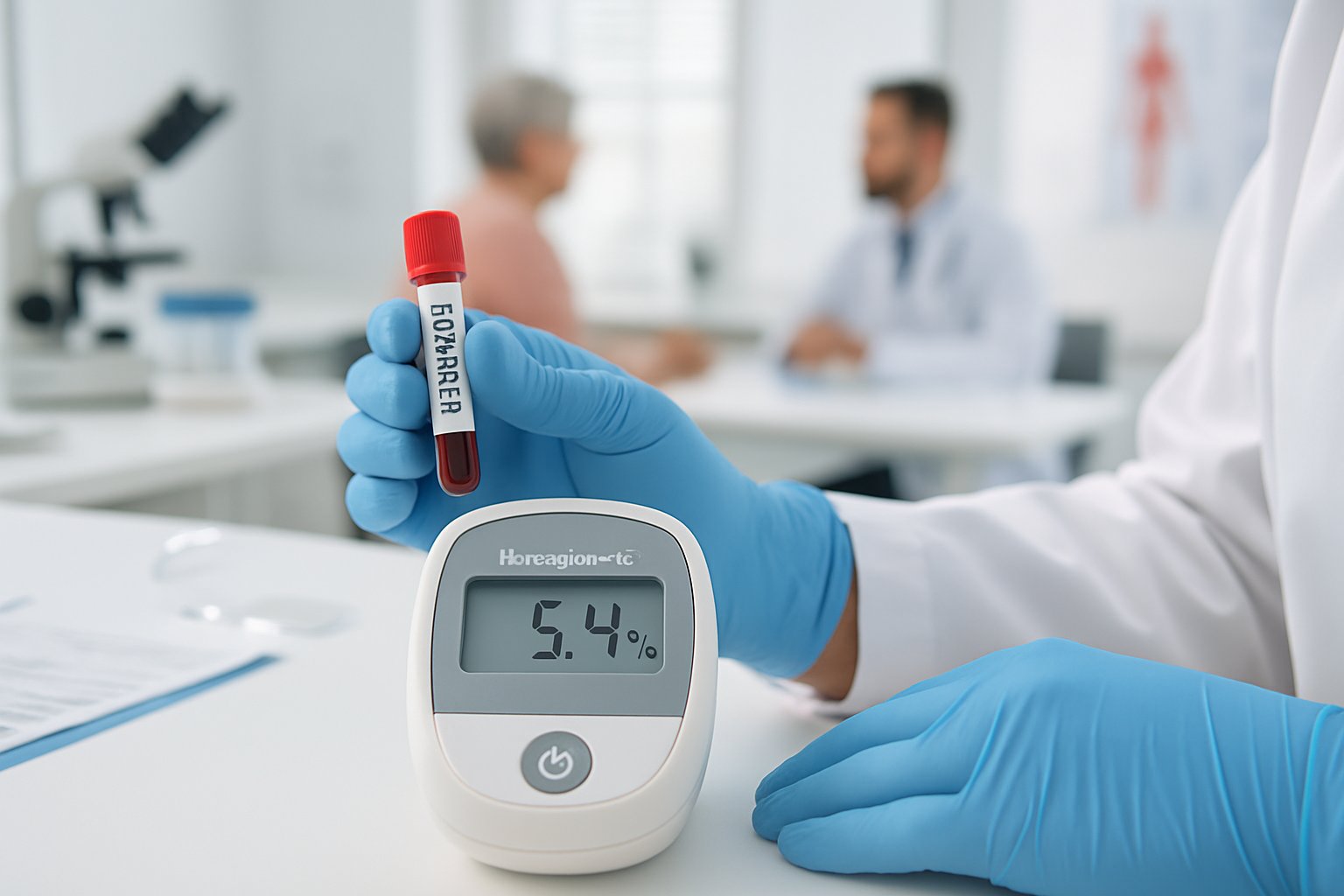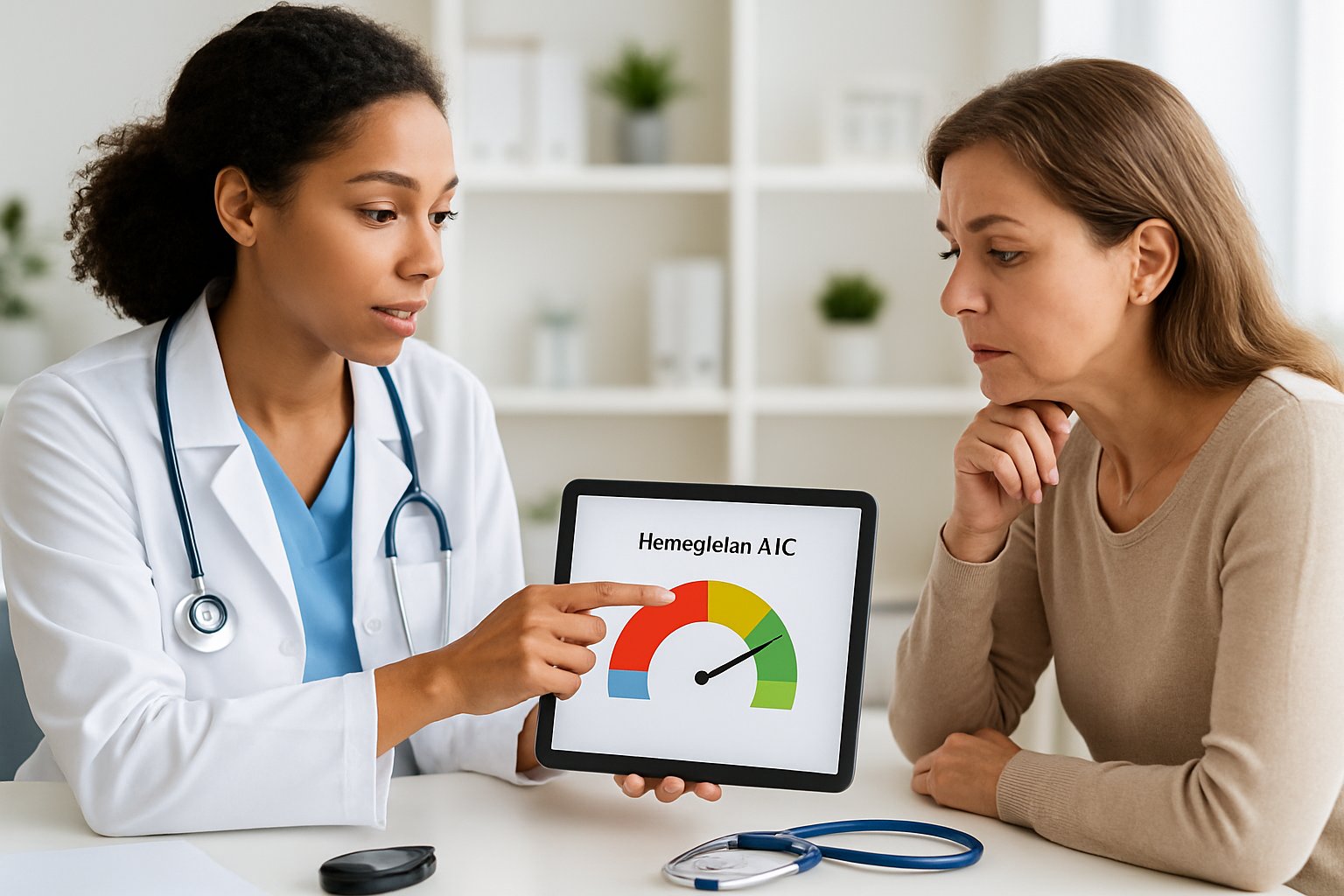When your hemoglobin A1C is high, it means your blood sugar has been elevated for the past two to three months. High A1C levels increase your risk of serious health problems including heart disease, kidney damage, nerve problems, and vision loss. The good news is that with proper treatment and lifestyle changes, you can lower your A1C and reduce these health risks.

The A1C test measures how much glucose has attached to your red blood cells over time. Normal levels are below 5.7%, while readings of 5.7% to 6.4% indicate prediabetes, and 6.5% or higher confirms diabetes[1]. Understanding what these numbers mean and taking action early can help prevent complications.
Many people don’t realize how much damage high blood sugar can cause throughout the body. From affecting your heart and kidneys to damaging nerves and blood vessels, elevated A1C levels require immediate attention. Learning how to manage and lower your A1C through diet, exercise, medication, and regular monitoring can help you take control of your health.
Key Takeaways
- High A1C levels indicate poor blood sugar control over 2-3 months and increase the risk of serious complications like heart disease and kidney damage
- A1C levels below 5.7% are normal, 5.7-6.4% indicate prediabetes, and 6.5% or higher suggests diabetes
- You can lower high A1C through healthy eating, regular exercise, stress management, proper medication, and consistent blood sugar monitoring
What Is Hemoglobin A1C and Why Is It Important?

Hemoglobin A1C measures how glucose attaches to red blood cells over time. This test provides a more complete picture of blood sugar control than single daily readings.
How the A1C Test Works
The A1C test measures glucose attached to hemoglobin[2] over the past two to three months. Hemoglobin is a protein inside red blood cells that carries oxygen throughout the body.
When blood glucose levels are high, more glucose molecules stick to hemoglobin proteins. This process is called glycation, creating glycated hemoglobin or HbA1c.
Red blood cells live for about three months. The A1C test shows what percentage of hemoglobin proteins have glucose attached to them during this timeframe.
Higher blood glucose levels mean more glucose attaches to hemoglobin. This creates a higher A1C percentage, reflecting poorer blood sugar control over the previous months.
A1C Versus Daily Blood Sugar Testing
Daily blood sugar testing shows glucose levels at specific moments. A1C testing reveals average blood glucose patterns over months.
Daily finger stick tests can vary based on meals, exercise, stress, and medications. A1C levels provide a stable picture that smooths out these daily ups and downs.
The A1C percentage converts to estimated average glucose[2] readings. For example, an A1C of 7% equals an average blood sugar of 154 mg/dL.
Both tests serve different purposes. Daily testing helps with immediate decisions about food, exercise, and medication timing.
Interpreting A1C Results
A1C results appear as percentages that indicate average blood sugar control:
- Below 5.7%: Normal, no diabetes
- 5.7% to 6.4%: Prediabetes range
- 6.5% or higher: Diabetes diagnosis
For people with diabetes, most adults should target an A1C below 7%[2]. Some may need different targets based on their health conditions and treatment goals.
The higher the A1C levels, the greater the risk of diabetes complications. Consistently high readings over several years increase chances of nerve damage, kidney problems, and heart disease.
Healthcare providers use A1C testing every three to six months to monitor diabetes management effectiveness.
What Causes High A1C Levels?

High A1C levels result from several key factors including undiagnosed diabetes or prediabetes, poor blood sugar control from dietary choices, and problems with medication management. These causes often work together to keep blood sugar elevated over months.
Underlying Health Conditions
The most common cause of high A1C is diabetes that hasn’t been diagnosed yet. People with type 2 diabetes may have elevated blood sugar for years before getting tested.
Prediabetes also raises A1C levels to 5.7% to 6.4%. This condition means the body struggles to process sugar normally but hasn’t reached full diabetes levels yet.
Type 1 diabetes occurs when the pancreas stops making insulin. Without enough insulin, blood sugar stays high constantly. This autoimmune condition usually develops in children and young adults.
Type 2 diabetes develops when the body becomes resistant to insulin or doesn’t make enough. This form is more common in adults and often links to weight and lifestyle factors.
Other health conditions can affect A1C accuracy. Kidney failure, liver disease, and blood disorders[1] like sickle cell anemia may cause false readings.
Some people have reduced insulin sensitivity. This means their cells don’t respond well to insulin, keeping blood sugar high even with normal insulin levels.
Lifestyle and Dietary Factors
Poor eating habits are a major cause of high A1C levels. Foods high in sugar and refined carbs cause frequent blood sugar spikes.
Common problem foods include:
- White bread and pasta
- Sugary drinks and sodas
- Candy and desserts
- Processed snacks
- Fried foods
Lack of exercise makes the problem worse. Physical activity helps muscles use glucose and improves how the body responds to insulin.
High blood sugar develops when people eat too many carbs without enough activity to burn them off. The body can’t keep up with processing all the sugar.
Stress also raises A1C levels. When stressed, the body releases hormones that increase blood sugar. Chronic stress keeps these levels elevated over time.
Poor sleep patterns affect blood sugar control too. Not getting enough quality sleep makes the body less sensitive to insulin.
Medication and Insulin Adherence
People with diabetes who don’t take their medications properly often have high A1C levels. Skipping doses or taking the wrong amounts prevents good blood sugar control.
Insulin problems are especially serious for people with type 1 diabetes. Missing insulin shots causes blood sugar to rise quickly and stay high.
Some people with type 2 diabetes need insulin but resist starting it. They may fear needles or think insulin means their condition is getting worse.
Wrong medication timing also causes issues. Taking diabetes medicines at the wrong times makes them less effective at controlling blood sugar.
Common medication problems include:
- Forgetting to take daily pills
- Not adjusting insulin for meals
- Stopping medicine without doctor approval
- Using expired medications
Cost issues prevent some people from getting their medicines regularly. This leads to gaps in treatment and higher A1C levels over time.
Symptoms and Warning Signs of High A1C

High A1C levels indicate poor blood glucose control over several months, leading to recognizable physical symptoms and immediate health concerns. These warning signs often develop gradually but can significantly impact daily life and well-being.
Physical and Emotional Symptoms
High A1C levels create several noticeable symptoms that affect both body and mind. Excessive thirst occurs when kidneys work harder to remove excess glucose[3], pulling fluids from tissues.
Frequent urination happens because the body tries to flush out extra sugar through urine. This creates a cycle where people drink more water but need to urinate more often, especially at night.
Visual and Energy Changes:
- Blurred vision develops when high blood glucose levels pull fluid from eye tissues
- Fatigue occurs because cells cannot properly use glucose for energy
- Increased hunger results from cells being starved of usable fuel
Mood changes like irritability and sadness can develop[3] as blood glucose levels affect brain function. Some people experience difficulty concentrating or feel more stressed than usual.
Skin problems include slow-healing cuts, dry and itchy skin, and frequent infections. Yeast infections become more common because yeast feeds on excess sugar in the body.
Short-Term Health Impacts
Elevated A1C levels create immediate health risks that require attention. Nausea and stomach pain can develop as high blood glucose affects digestion and nerve function in the stomach.
Infection Risks:
- Weakened immune system makes fighting infections harder
- Bacteria thrive in high-sugar environments
- Wounds heal slower than normal
Numbness or tingling in hands and feet[3] signals early nerve damage from prolonged high blood glucose levels. This condition can worsen without proper blood sugar management.
Unexplained weight loss occurs when the body cannot use glucose properly and starts breaking down muscle and fat for energy. This symptom appears more often in people with type 1 diabetes.
Emergency Warning Signs:
- Fruity-smelling breath
- Deep, rapid breathing
- Severe nausea and vomiting
- Confusion or loss of consciousness
These severe symptoms require immediate medical attention as they may indicate diabetic ketoacidosis, a life-threatening condition.
Health Risks and Serious Complications of High A1C

High A1C levels significantly increase the risk[1] of heart disease, stroke, kidney failure, and nerve damage that can lead to amputation. These diabetes complications develop because elevated blood sugar damages blood vessels and organs throughout the body over time.
Cardiovascular Disease and Stroke
High A1C levels cause major damage to the heart and blood vessels. Blood vessel damage can start at A1C levels above 7%[1], putting people at risk for serious heart problems.
Diabetes increases the risk of heart disease by harming blood vessels and nerves that control heart function. High blood sugar causes plaque to build up in arteries, which blocks blood flow to the heart.
Key cardiovascular risks include:
- Heart attacks from blocked arteries
- High blood pressure from damaged blood vessels
- High cholesterol levels
- Heart failure from weakened heart muscle
Stroke risk also increases significantly with high A1C. Damaged blood vessels in the brain can become blocked or burst. This cuts off oxygen to brain cells and causes permanent damage.
People with diabetes are twice as likely to have heart disease or stroke compared to people without diabetes. The higher the A1C level, the greater these risks become.
Kidney Damage and Kidney Failure
One in three adults with diabetes develops diabetic kidney disease[1], and this risk increases as A1C levels rise. High blood sugar damages the small blood vessels in the kidneys that filter waste from blood.
Diabetic nephropathy develops slowly over many years. The kidneys gradually lose their ability to clean waste and extra fluid from the body. Early kidney damage often has no symptoms.
Warning signs of kidney disease include:
- Protein in the urine
- Swelling in legs, ankles, or feet
- High blood pressure
- Feeling tired and weak
Without treatment, kidney disease progresses to kidney failure. People with kidney failure need dialysis treatments or a kidney transplant to stay alive. Dialysis uses a machine to filter blood when kidneys can no longer do this job.
Keeping A1C levels below 7% can help protect kidney function and prevent nephropathy from getting worse.
Nerve and Vision Damage
High blood sugar damages nerves throughout the body, causing diabetic neuropathy. About half of people with diabetes develop nerve damage[1], which most commonly affects hands and feet.
Symptoms of nerve damage include:
- Burning pain and tingling
- Numbness in hands or feet
- Poor balance and coordination
- Muscle cramps and weakness
Severe neuropathy in the feet can lead to serious infections and amputation. People may not feel cuts or sores because of numbness, allowing infections to spread.
High blood sugar also damages the eyes[1], leading to vision problems and blindness. Diabetic retinopathy occurs when blood vessels in the retina become damaged, causing bleeding and swelling.
Eye complications include:
- Diabetic retinopathy with vision loss
- Cataracts that cloud the lens
- Glaucoma from increased eye pressure
Regular eye exams can catch problems early. Keeping blood sugar stable reduces the risk of severe vision loss and other complications.
Blood Sugar Monitoring and Assessment Tools
People with high A1C levels need reliable ways to track their blood sugar levels daily. Two main types of devices help monitor glucose: traditional glucometers that require finger pricks and newer continuous glucose monitors that track levels automatically.
Self-Monitoring With Glucometers
A glucometer is a small device that measures blood sugar using a drop of blood from a finger prick. The device requires test strips and a small needle called a lancet to get the blood sample.
Most glucometers give results in 5 to 10 seconds. The person places a test strip into the device, pricks their finger, and puts the blood drop on the strip.
Key benefits of glucometers:
- Accurate readings when used correctly
- Less expensive than continuous monitors
- Easy to carry and use anywhere
- Covered by most insurance plans
People with diabetes typically check their blood sugar 1 to 4 times per day. Those with high A1C levels may need to test more often to track how food, exercise, and medication affect their levels.
Regular blood glucose monitoring[4] helps people make better decisions about meals, exercise, and medication timing. Research shows that more frequent testing leads to better A1C control.
Continuous Glucose Monitoring Technologies
A continuous glucose monitor (CGM) uses a tiny sensor placed under the skin to track blood sugar levels every few minutes. The sensor sends data to a smartphone app or separate device.
- Shows blood sugar trends throughout the day
- Alerts users to dangerous highs or lows
- No finger pricks needed for most decisions
- Tracks overnight glucose levels
CGMS devices can significantly reduce A1C levels[1] compared to traditional glucose meters. The constant data helps people see how different foods and activities affect their blood sugar.
Most CGM sensors need replacement every 7 to 14 days. The devices cost more than glucometers but provide much more detailed information about glucose patterns.
Some people use both a CGM and a glucometer. They rely on the CGM for daily tracking and use the glucometer to double-check readings when making important treatment decisions.
Managing and Lowering High A1C

Lowering A1C levels takes time[1] and requires changes in diet, exercise, medication management, and stress reduction. A comprehensive approach combining these strategies provides the most effective long-term blood sugar control.
Healthy Diet and Balanced Nutrition
A balanced diet forms the foundation of effective blood sugar management. People with high A1C should focus on foods that prevent blood sugar spikes while providing essential nutrients.
Foods to Include:
- High-fiber vegetables like broccoli, spinach, and bell peppers
- Lean proteins such as chicken, fish, eggs, and tofu
- Whole grains including quinoa, brown rice, and oats
- Healthy fats from nuts, seeds, and olive oil
Foods to Limit:
- Refined carbohydrates like white bread and pasta
- Sugary drinks and fruit juices
- Processed snacks and sweets
- Fried foods high in unhealthy fats
A diabetes educator or dietitian can create personalized meal plans. They help patients understand carbohydrate counting and portion control. Testing blood sugar two hours after meals[1] helps identify which foods cause the biggest spikes.
Weight management often improves naturally with a healthy diet. Even losing 5-10 pounds can significantly impact A1C levels.
Physical Activity and Strength Training
Regular physical activity improves insulin sensitivity and helps muscles use glucose more effectively. Exercise can enhance insulin sensitivity for up to 24 hours[1] after each workout session.
Recommended Activities:
- 150 minutes of moderate exercise per week
- Strength training 2-3 times weekly
- Walking, swimming, or cycling
- Resistance exercises using weights or bands
During physical activity, muscles consume glucose for energy. This natural process lowers blood sugar levels immediately and improves long-term blood sugar control.
Strength training builds muscle mass, which increases the body’s ability to store and use glucose. More muscle tissue means better glucose uptake from the bloodstream.
People should start slowly and gradually increase intensity. Those taking insulin or certain medications may need to monitor blood sugar before and after exercise to prevent low blood sugar episodes.
Medication, Insulin, and Medical Team Support
Healthcare providers may prescribe medications when diet and exercise alone cannot achieve A1C targets. An endocrinologist specializes in diabetes management and can adjust treatment plans as needed.
Common Medications:
- Metformin: Reduces glucose production in the liver
- Insulin: Essential for type 1 diabetes, sometimes needed for type 2
- GLP-1 agonists: Slow digestion and improve insulin sensitivity
- SGLT-2 inhibitors: Help kidneys remove excess glucose
Each person’s A1C goal varies based on age, health conditions, and diabetes type. Most adults aim for an A1C below 7%, though some may have different targets.
Regular medication adherence is critical for success. Patients should never adjust doses without consulting their medical team. Healthcare providers may recommend monitoring blood sugar at home[1] to track progress between appointments.
Continuous glucose monitors provide real-time data and can significantly improve A1C levels when used consistently.
Stress Management and Lifestyle Adjustments
Stress directly impacts blood sugar levels[1] by triggering hormone release that increases glucose production. Managing stress becomes essential for diabetes management and achieving A1C goals.
Effective Stress Reduction Methods:
- Regular meditation or deep breathing exercises
- Yoga or tai chi classes
- Journaling to process emotions
- Talk therapy with a counselor
Quality sleep affects blood sugar control. Poor sleep patterns can worsen insulin resistance and make managing blood sugar more difficult.
Consistent daily routines help stabilize blood sugar levels. Eating meals at regular times and taking medications on schedule supports better glucose control.
Social support from family, friends, or diabetes support groups provides motivation and practical help. Many people find sharing experiences with others who understand diabetes challenges particularly valuable for long-term success.
Setting A1C Targets and When to Seek Medical Advice

A1C targets vary based on individual health factors and medical conditions. Healthcare professionals play a key role in setting personalized goals and adjusting treatment plans.
Individualized A1C Goals
A1C targets differ for each person[5] depending on age, health conditions, and life expectancy. Most adults with diabetes aim for an A1C below 7%.
Standard A1C Targets:
- Normal individuals: Below 5.7%
- Most adults with diabetes: Below 7%
- Older adults with multiple conditions: 7.5-8%
- Children with type 1 diabetes: Below 7-8%
Some people may need higher A1C goals. Older adults with serious health problems might target 8% or higher. This prevents dangerous low blood sugar episodes.
People with PCOS and diabetes may follow similar targets. Their doctors consider insulin resistance and other hormone factors when setting goals.
Healthcare providers adjust A1C targets[6] based on the patient’s ability to manage blood sugar safely. Frequent low blood sugar episodes might require higher targets.
The Role of Health Professionals
Doctors use A1C tests to monitor diabetes management and adjust treatments. They evaluate if current treatments are working[7] and make changes when needed.
Healthcare teams include doctors, diabetes educators, and dietitians. They work together to create treatment plans that fit each person’s lifestyle and health needs.
Patients should contact their healthcare provider when A1C levels stay above their target range. Regular A1C testing every 3 months[2] helps track progress and catch problems early.
Medical professionals also help patients understand their A1C results. They explain what the numbers mean and how to improve blood sugar control through diet, exercise, and medications.
Frequently Asked Questions

High A1C levels raise specific concerns about health risks, daily management, and monitoring needs. Understanding the complications, lifestyle adjustments, and warning signs helps people make informed decisions about their diabetes care.
What health complications can arise from a consistently elevated A1C level?
Consistently high A1C levels lead to serious health problems that affect multiple body systems. High A1C increases the risk of heart disease, kidney disease, and nerve damage[1] over time.
Heart disease becomes more likely as high blood sugar damages blood vessels. This damage causes plaque buildup in arteries, raising the risk of heart attacks and strokes.
Vision problems develop when high glucose levels harm tiny blood vessels in the eyes. Diabetic retinopathy, cataracts, and glaucoma can cause permanent vision loss without proper control.
Nerve damage affects about half of people with diabetes. High blood sugar damages nerves in the hands, feet, and digestive system, causing pain, numbness, and loss of function.
Kidney disease occurs in one in three adults with diabetes. High glucose damages kidney blood vessels, reducing their ability to filter waste from the blood.
Gum disease becomes more common as high blood sugar feeds harmful bacteria in the mouth. This leads to infections, tooth loss, and other oral health problems.
How does a high A1C impact the management of diabetes?
A high A1C signals that current diabetes management needs immediate changes. Healthcare providers use these results to adjust treatment plans and prevent complications.
Medication adjustments become necessary when A1C levels stay above target ranges. Doctors may increase dosages, add new medications, or switch to different treatments.
More frequent monitoring becomes essential for people with elevated A1C levels. This includes both regular A1C testing and daily blood sugar checks at home.
Treatment goals may need revision based on individual health factors. While most adults aim for an A1C below 7%, some may need different targets based on their condition.
Healthcare visits increase in frequency to track progress and make timely adjustments. This closer monitoring helps prevent complications from developing.
What lifestyle changes are recommended for someone with a high A1C?
Diet changes form the foundation of A1C management. People should focus on high-fiber foods, lean proteins, and healthy fats while avoiding refined carbohydrates and sugary drinks.
Regular exercise improves insulin sensitivity and helps muscles use glucose more effectively. Most people with diabetes should aim for at least 150 minutes of moderate exercise per week[1].
Stress management techniques like yoga, meditation, and journaling help control blood sugar. Chronic stress raises glucose levels and makes diabetes harder to manage.
Weight management through proper diet and exercise helps improve insulin function. Even small weight losses can lead to meaningful A1C improvements.
Blood sugar monitoring at home provides daily feedback on food choices and activities. This information helps people understand what affects their glucose levels.
Sleep quality impacts blood sugar control and insulin sensitivity. Getting adequate, consistent sleep supports better glucose management.
At what point does an elevated A1C level become an emergency?
An A1C level alone typically does not constitute a medical emergency. However, extremely high levels combined with symptoms require immediate medical attention.
A1C levels above 10% indicate poor blood sugar control and increased complication risk. These levels need prompt medical intervention and treatment adjustments.
Emergency situations occur when high blood sugar causes diabetic ketoacidosis or hyperosmolar syndrome. These conditions require immediate hospital treatment.
Symptoms like extreme thirst, frequent urination, vomiting, and confusion need emergency care. These signs may indicate dangerously high blood sugar levels.
New diagnosis of diabetes with very high A1C levels may require hospitalization. This ensures proper treatment initiation and patient education.
What are the signs that indicate your A1C levels might be too high?
High A1C levels often develop without obvious symptoms in early stages. Many people discover elevated levels only through routine blood testing.
Increased thirst and frequent urination are common early signs. High blood sugar causes the body to try removing excess glucose through urine.
Fatigue and weakness occur when cells cannot properly use glucose for energy. This leaves people feeling tired despite adequate rest.
Blurred vision happens when high glucose levels cause fluid shifts in the eyes. This symptom may come and go with blood sugar changes.
Slow-healing cuts and frequent infections indicate compromised immune function. High blood sugar makes it harder for the body to fight infections and repair tissue.
Unexplained weight loss can occur despite normal eating habits. This happens when the body breaks down muscle and fat for energy instead of using glucose.
How often should individuals with high A1C levels monitor their blood sugar?
People with high A1C levels need more frequent blood sugar monitoring than those with good control. The exact frequency depends on individual circumstances and treatment plans.
Daily blood sugar testing helps track patterns and treatment effectiveness. Healthcare providers typically recommend testing multiple times per day for people with elevated A1C.
A1C testing should occur every 3 months for people with high levels. Most people with diabetes should get an A1C test at least twice a year[1], but more frequent testing helps track improvement.
Continuous glucose monitors provide real-time blood sugar data. These devices help people with high A1C levels make immediate adjustments to food, activity, and medication.
Testing frequency may decrease as A1C levels improve and stabilize. Healthcare providers adjust monitoring schedules based on individual progress and control.
References
- 6.5% or higher confirms diabetes. https://www.verywellhealth.com/what-happens-when-a1c-is-too-high-5118384 Accessed October 23, 2025
- A1C: What It Is, Test, Levels & Chart. https://my.clevelandclinic.org/health/diagnostics/9731-a1c Accessed October 23, 2025
- Excessive thirst occurs when kidneys work harder to remove excess glucose. https://www.verywellhealth.com/hyperglycemia-symptoms-and-signs-11772280 Accessed October 23, 2025
- Diabetes Blood Glucose Monitoring: A1C and Meter Testing. https://www.umassmed.edu/dcoe/diabetes-education/blood-sugar/ Accessed October 23, 2025
- Individualizing your patient’s A1C target. https://www.diabetes.ca/managing-my-diabetes/tools---resources/individualizing-your-patient%E2%80%99s-a1c-target Accessed October 23, 2025
- A1C Levels for Type 2 Diabetes: A Guide. https://resources.healthgrades.com/right-care/diabetes/a1c-levels-for-type-2-diabetes Accessed October 23, 2025
- Monitoring A1c Levels in Diabetes. https://healthanswers.pfizer.com/diabetes/self-care-living-with/monitoring-a1c-levels-in-diabetes Accessed October 23, 2025
